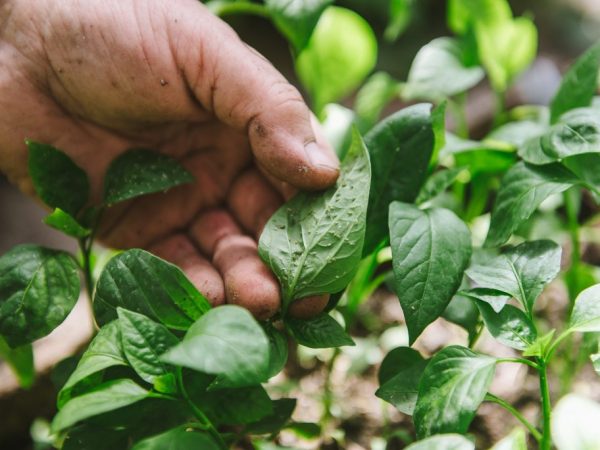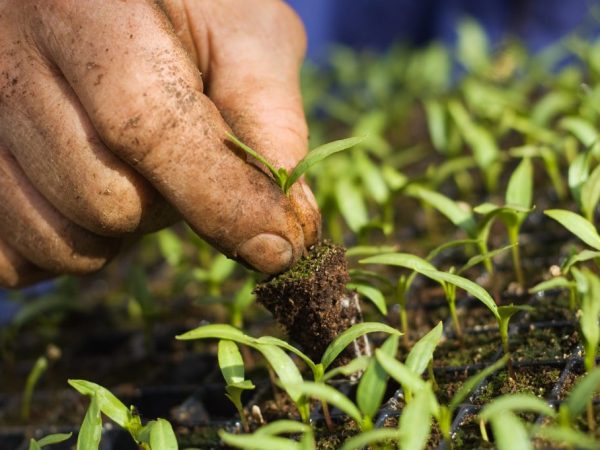Common diseases of sweet pepper seedlings
Sweet bell pepper is a culture characterized by a pleasant aroma and rich taste. Since all varieties are grown using seedlings, they can be exposed to negative environmental factors. Consider what diseases of sweet pepper seedlings can be encountered and what methods of combating diseases and parasites should be used.

Common diseases of sweet pepper seedlings
General information
Bell peppers are unpretentious in cultivation. All problems lie only in poor quality and unscrupulous care of these crops.
For this reason, experts advise to carry out prevention, because it is much easier to prevent a disease than to try to get rid of it for a long time. Moreover, under the influence of the disease, the amount of the crop will still be lower than that of healthy plants.
Blackleg impact
Blackleg is more common than other diseases of the nightshade family. Infection begins from the main stem of the bush. Over time, it takes on a black tint. If the plant is not treated in time, then the black areas will begin to grow and occupy the entire area of the bush.
If the entire bush is completely affected by the disease, then further treatment is meaningless. It is necessary to destroy the entire bush (burn away from the garden).
Eliminating the problem
The main reasons for the appearance of the disease are considered to be poor-quality abundant watering or a sharp change in the temperature regime of the environment, therefore, it is necessary to plant and water the culture as correctly as possible.
You can get rid of the primary symptoms only if watering is normalized. It is recommended to water bell peppers no more than 2 times a week, and it is important to regulate the amount of watering, because the root system of sweet peppers does not like a lot of moisture. The maximum volume of water per 1 bush is 1.5-2 liters. You also need to pay attention to the time of planting in open ground. It is not recommended to plant seedlings in the soil if there is a risk of sudden frosts. Planting should be done in May when the soil is warm enough.
Pillar

Determining the treatment
Symptoms of the disease:
- a sharp loss of moisture in the leaves, yellowing and leaf fall;
- violation of the growth of the bush;
- fruits begin to bend and change their shape;
- the aroma and taste of sweet pepper is poorly felt.
Only pests can carry this disease, therefore the prevention and treatment of this disease is based on the destruction of parasites.
Eliminating the problem
In order to minimize the risk of the disease, it is necessary to carry out preventive measures and treatment on time. It is necessary to regularly loosen the soil and remove weeds, because most often parasites are found in neglected areas.
If such a disease of sweet pepper seedlings has spread, you need to immediately treat with antiparasitic agents. Experts advise using only those substances that do the least harm to the plant itself. It is recommended to spray once every 10 days with drugs such as Confidor or Stolstop. You can also use folk remedies (tincture of garlic or onion peel).
Spotted mosaic
Disease symptoms:
- active yellowing of seedling foliage begins;
- rare small dark spots are observed.
If the spots are quite small, it means that the treatment of the disease can still be carried out without harm to the yield. As soon as the spots become larger, it will be simply impossible to get rid of the disease, because the leaves and fruits will begin to deform and the yield will decrease to zero.
Eliminating the problem
If you are going to carry out preventive measures, then it is advisable to use milk whey or milk diluted with water in a 1: 1 ratio. Each bush is watered with 1 liter of water, at intervals of 3 days, until the disease is completely eradicated.
If the disease nevertheless made itself felt, then you need to use special chemicals, like Oxyhom or Regent. It is necessary to breed them and spray them exactly according to the instructions on the package.
Fungal infections

Diseases from an early stage
It is important to pay attention to those diseases that are provoked by a variety of fungi. It is believed that their appearance is associated with poor-quality, abundant watering.
In order to get rid of infection in open ground, you need to normalize watering. It should be carried out once every 3 days. If the infection occurs in the greenhouse, then it is necessary to regularly ventilate the room so that the level of humidity in the air drops slightly.
Fusarium and gray rot
Fusarium is one of the main diseases of sweet pepper. It manifests itself in the fact that the whole bush begins to turn yellow, after which it falls off. Also, in the lower part of the main stem, black spots are observed, similar to a black stem.
Gray rot occurs due to the fact that the root system receives a large amount of moisture. This can be justified not only by abundant watering, but also by frequent rains. Gray spots with a slight brown tint begin to form on the leaves.
Treatment of diseases
Unfortunately, it is impossible to get rid of Fusarium. The only way out of this situation is the complete destruction of the damaged bush. The vacated space must be immediately treated with a manganese solution to destroy all bacteria.
It is a little easier to get rid of gray rot.
- All damaged areas should be trimmed.
- Spraying with fungicides is carried out.
White or apical rot
White rot is most often found in the lower part of the plant. The root zone begins to be covered with light shades. This also leads to the fact that sclerotia begins to actively develop in the root system. As a result, much less nutrients enter the root system.
Top rot is characterized by the formation of dark spots with an unpleasant odor on the surface of the fruit. This disease develops due to the fact that the plant receives large amounts of magnesium or potassium.
Prevention and treatment
In the fight against white rot, it is advisable to adjust the temperature regime of the greenhouse. You should also mulch the root soil immediately after planting. As a means of destroying the disease, you can use folk methods - powder from chalk or coal.
From top rot, watering should be normalized and carried out no more than 2 times a week. You should also ensure that the roots receive the right amount of oxygen. To do this, they carry out frequent loosening of the soil and remove weeds. Some experts advise feeding with calcium fertilizers, which neutralize the effects of potassium and magnesium.
Aphids or spider mites
You can fight them both with folk remedies and with chemicals. It is generally accepted that aphids are not independent pests. It completely depends on the influence of black ants, so you need to get rid of ants too.
Spider mites are found only in greenhouses. If you notice the appearance of cobwebs on the seedlings, then it's time to fight pests.
Getting rid of parasites
Ant control is carried out using special chemicals such as Zaslon. All adjacent areas are sprayed with it. Aphids are removed using copper-containing preparations such as Oxyhom.
Spider mites can be destroyed, both with the help of chemicals and with the help of folk methods. In terms of chemicals, preference should be given to acaricides. As folk remedies, a pepper solution will come to the rescue (for 1 liter of warm water, 1 tablespoon of hot cayenne pepper is used).
Prevention of parasites and diseases
In order to protect sweet peppers from the influence of parasites and diseases, it is advisable to carry out the following preventive measures:
- every 2-3 years it is necessary to change the surface layer of the soil in the greenhouse;
- give preference to hybrid varieties, because they are more resistant to negative environmental factors (humidity and temperature);
- seeds and greenhouses for growing crops must be decontaminated;
- plantings should not be dense: the distance between bushes and plants should not be less than 40 cm - it all depends on the variety;
- only healthy seedlings are suitable for planting, without damaged areas.
Conclusion
As you can see, almost all diseases of sweet pepper seedlings occur due to improper care. It is necessary to deal with them precisely by normalizing the cultivation rules.


